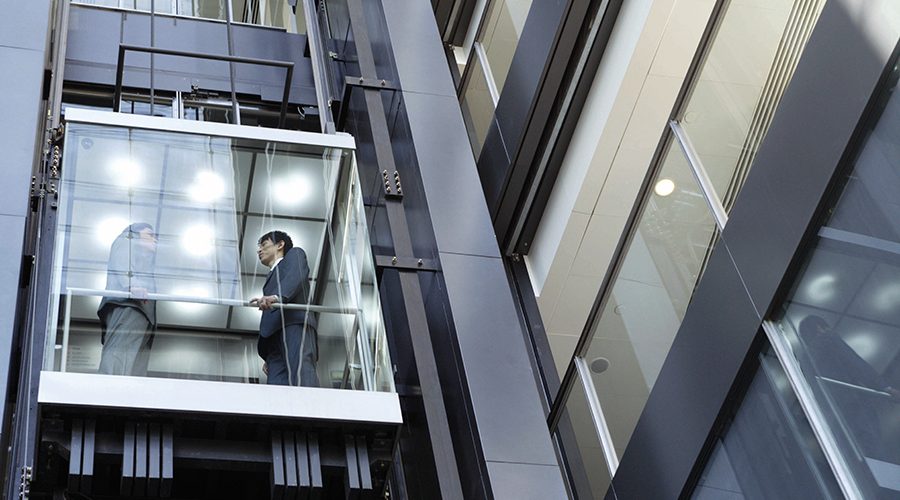Regular preventative maintenance of lifts, escalators, platform and stair lifts will optimise the initial investment, ensuring the performance of the installation to the expected service life. Dean Taylor, Regional Director for Vertical Transportation at TÜV SÜD Dunbar Boardman, explores further.
TÜV SÜD – Lift Consultants UK
When considering a new maintenance contractor, the “responsible person” (lift owner) should firstly allow potential new maintenance contractors sufficient time and access to survey the relevant installation and equipment. For example, Sheffield Teaching Hospitals NHS Trust appointed us to carry out a technical survey and traffic analysis to establish the level of refurbishment or renewal of the lifts and improve traffic handling. We also developed a fully bespoke technical specification, which was tendered by the Trust.
The lift owner should also make the health and safety file available, as well as the responsible person’s instruction manual, so that the prospective maintenance contractor is aware of relevant hazards. Records of modernisation work completed since installation; previous service history, including breakdowns and repairs; records from the original test and placing into service; and the reports of thorough examinations and any supplementary tests should also be disclosed.
To ensure the most effective outcome for both the lift owner and the maintenance contractor, the responsible person should also specify their maintenance objectives in relation to the regulations, standards and directives with which they must comply.
They should also advise the potential maintenance contractor of other issues, such as the frequency and intensity of usage of the plant and any additional or special features. Where the original manufacturer’s documents have been lost, the responsible person should try to source replacements. They should also make available any essential special tools provided with the plant.
Compliance complexity
When first brought into use, conventional passenger lifts, escalators, platforms and stair lifts must all meet the requirements for safety and conformity with either the Machinery Directive or Lift Directive. Thereafter, the lift owner is legally bound to ensure both lift and passenger safety, as well as keep up to date with any changes that might affect their equipment.
There are a whole host of standards, regulations, codes of practice and guidance covering the safe and efficient operation of lifts, at least 23 areas of principal guidance – too many for me to detail here. However, three key ones to consider are:
The Provision and Use of Work Equipment Regulation 1998 (PUWER) places duties on owners and operators over equipment that is provided for people to use at work. It requires (amongst others) that it is suitable for the intended use, maintained in a safe condition, and inspected to ensure it is correctly installed and does not deteriorate.
The Lifting Operations and Lifting Equipment Regulations 1998 (LOLER) requires the lift owner to have their lift(s) thoroughly inspected at six-monthly intervals, or in accordance with their own examination scheme, as required by Regulation 9 of LOLER. It is also the duty of the lift owner to employ a competent person to undertake these inspections.
The Health and Safety at Work Act 1974 requires those who own or occupy premises to keep the lift equipment in safe working order and therefore arrange regular equipment maintenance.
Hazards
Undertaking maintenance activities can potentially expose people to hazards, but there are four issues that merit particular attention because of the severity of the harm that could be involved, and which are also commonly encountered during lift maintenance:
Asbestos – the health consequences of disturbing asbestos when drilling holes into the building fabric or replacing panels can be severe, as can the clean-up costs.
Falls from height – maintenance work often involves using access equipment to reach raised sections of plant and machinery, from which people can fall or drop things below.
Isolation, lock off arrangements and permits to work – essential to enable maintenance work to be conducted safely.
Worker safety – to enable both in-house and contracted maintenance staff to work in safety you will need to properly brief them on your site and processes, and ensure they follow safe working practices.
Lifetime assurance
In order to preserve the operational integrity and safety of an elevator installation, preventative maintenance is of course the best practice route. Whilst the extent of the maintenance that is required may vary according to the type of installation, a fully comprehensive maintenance arrangement will provide maximum cover for the lift owner and fulfil the benefits described above.
This is because this type of agreement should anticipate the needs of the equipment and therefore the cost and provision of parts requiring replacement as they become worn. Manufacturers/maintainers can therefore spread their costs to the benefit of the lift owner, over a period which may extend for up to 20 years. If there is a breakdown, it also secures the availability of trained personnel, who can respond promptly to rectify the problem.
While lesser maintenance agreements are available, and may be tempting when considering lifetime costs upfront, they will simply not afford the same long-term benefits in relation to elevator service availability for users, safety and cost. It is therefore vitally important to consider the scope of what is being offered, the exclusions and to study the small print.
Maintenance and inspections of lifts is not an optional feature and it is therefore essential to ensure that it is carried out correctly and in a timely manner. In addition to the requirement that equipment should be of good mechanical construction, of sound material and adequate strength, the statutory provisions extend to requiring appropriate maintenance.










